Organic search is one of the most common ways Internet users find new businesses or reach those they already know about. It plays a significant part in many user journeys, and you may have heard that a good SEO strategy should always include optimising for Search Engine Results Pages (SERPs).
But what exactly are SERPs, how do they work, and can they really make a big difference in your brand's digital visibility? In this guide, we go over what SERPs are in the context of SEO, how search results are ranked, and best practices when it comes to optimizing for SERPs.
What are SERPs?
SERP is an acronym for Search Engine Results Page. It refers to the page that a search engine such as Google displays to users after they type in a search query. The results on many SERPs can be broken into two broad categories – organic and paid results. For instance, with Google, paid ads are generally placed at the top, followed by organic results underneath.
The rankings of organic search results are chosen by the search engine’s algorithm. This algorithm analyzes different factors to determine a web page’s quality and relevance to the query asked. The more popular a page is and the more relevant it is for the user, the higher it shows up on their SERPs.
Search engines like Google are always updating their ranking algorithms to provide the best results for users, and advertisers and businesses need to stay up to date with these changes to ensure their site pages adhere to the latest best practices.
Why SERPs are important in SEO?
SEO is all about optimising websites to appeal to search engines, and SERPs, naturally, are within the purview of SEO specialists. Google gets trillions of searches every year, with around 95% of clicks from organic search results. And over the years, it has been shown time and again that users who click on links from their searches click on those on the first page of SERPs.
That said, even on the first page of SERPs, not every position is equal. The higher a page is positioned on the first page, the more likely it is to get clicks and attention from searchers. Studies have shown that the top-ranking page for a search query generally gets 10 times more clicks than the 10th - so even if two results are both ranking on the first page, there is a stark difference as to how they are received, determined by their positioning alone.
All this to say, that ranking well on SERPs can be a fierce competition because of the potential benefits it brings. If your website is ranking at the top of the first page of search results, you stand to gain a significant amount of visibility which may eventually turn into leads and conversions for your business.
Ranking for SERPs is made even more complex when you consider the additional features that search engines like Google throw in the mix in their results pages.
As mentioned, paid ads tend to dominate the top of the page. There are also featured snippets – special boxes of text that are picked up from a web page’s content and displayed directly to quickly answer user queries in SERPs, so that they do not have to click into any pages – but more on that later.
How search results are ranked
The order of SERPs is typically determined by the search engine’s algorithms, which are designed to provide the most valuable and relevant information to its users. When it comes to Google – the world’s most popular search engine by far with a market share of 91.5% – there are several key factors that influence the order of its search results.
Relevance to user query and search intent
Google aims to provide results that are directly relevant to users’ search queries. The content should match the intent behind the search, considering phrases, keywords, and user context. Some examples of search intent are informational, navigational, transactional, and commercial.
Page content and keywords
The presence of relevant keywords in the meta tags, content, headings, and other on-page elements is vital. Google assesses how well a page’s content aligns with the search query by its usage of relevant keywords, and how often clusters of related keywords appear on-page. Too many or too few keywords signal to Google that the page may not be of high quality or relevant to the searcher.
Page authority and quality
High-quality content from authoritative sources tends to rank higher. Google has introduced EEAT, which stands for Experience, Expertise, Authoritativeness, and Trustworthiness as part of its Search Quality Rater Guidelines in December 2022. Though it is not a direct ranking factor, high EEAT can improve user trust and lead to more conversions on your site.
Mobile friendliness
With the increasing use of mobile devices such as smartphones and tablets, mobile friendliness is a ranking factor for Google’s SERPs. Websites that provide a seamless experience across mobile devices are more likely to rank higher, which can lead to increased visibility and traffic. Some features of a mobile friendly website include page layouts being optimized for small screens.
User experience and engagement
Metrics that measure user behaviour and engagement such as Click-through Rate (CTR), bounce rate, and dwell time help Google gauge the user experience of a site. Pages that keep users engaged – such as those with high CTRs and dwell time and low bounce rates – are favoured in SERPs.
Geographical relevance
Queries that are influenced by locality – such as businesses and marketplaces – have results that are often ranked based on geographical relevance. Google considers the location of the user and aims to provide search results that are relevant to their location. Some signals that websites give to Google to strengthen its geographical relevance include location-based domains and content in local languages.
How to maximize your chances of ranking well on SERPs
Ranking high on SERPs can make or break your business. Whether you are looking to start ranking higher for your target keywords or start ranking at all – below are some things you can do to maximize your ranking potential.
Ensure your website is indexable and crawlable
To increase your chances of your pages ranking well on SERPs, they need to be indexable and accessible to search engines. Search engines discover content by crawling and indexing, meaning they use robots – known as crawlers – to scan the Internet for new and updated content. If Google is unable to find and index your content, they cannot be pushed on SERPs as they do not officially exist to the search engine.
Create high-quality content
The best approach to creating content that is optimized for both users and search engines is by understanding what users are searching for, how they are searching, and what they are hoping to find. This includes finding the relevant keywords that have high search volumes, structuring your content so that it makes sense to users, and keeping up with other SEO best practices such as having clear headers, high quality images, and relevant internal linking.
When your pages are done well, it can create a positive feedback loop that contributes to higher rankings. This is because when searchers find value in a piece of content, they are more likely to stay on a webpage and explore more pages, which in turn signals to search engines that the content is worth reading and promoting.
Follow the best practices of on-site SEO
On-site SEO involves optimizing all the elements of a website that is shown on the page and as a part of the site, such as:
- Internal linking
Internal links to and from other relevant pages within your website can contribute to the context of the page, which can lead search engines to better understand what a page is about.
- Use of headers and sections
Content on page should have clear headers and sections, including proper use of H1s, H2s, and H3s.
- Use of keywords
The page should contain the relevant keywords that you wish to rank for. These target keywords should align with the purpose of your page, whether it is to provide information or to generate leads and conversions.
- Clear site architecture
Your website should have clear URLs, good internal linking, a coherent sitemap that allows search engines to crawl pages and page content easily. Sites with clear architectures can also lead to better user experience.
- Image optimization
Using high-quality images that have a descriptive alt text can benefit users with accessibility issues while helping search engines crawlers better understand the page.
Gain backlinks
Also known as external links, backlinks are links from other websites pointing to your website. This is seen as a vote of confidence for search engines, and backlinks from other high-quality websites can often improve your SERP positioning.
A few ways to increase backlinks include guest blogging, reaching out to industry influencers, or creating linkable assets like valuable data or infographics that others can find value in.
It is important to note the quality of the site providing the backlink. Backlinks from authoritative and reputable sites carry more weight, while those from low authority sites can potentially harm page rankings instead.
Other types of SERP features
Search engines like Google also showcase plenty of SERP features in their results, and new ones are always being tested and implemented. Below are some of the most common SERP features you will find and what each one means.
Featured Snippet
Featured snippets are designed to show a snippet of content from one of the top-ranking pages on a SERP. Here, a search engine such as Google attempts to summarise the most important and relevant information in response to a question for users’ quick access.
Featured snippets are usually displayed at the top of the SERP, although other results may occasionally be displayed above them. Common snippet formats include a list, a table, or a paragraph. Additionally, some featured snippets for instructional queries may be videos.
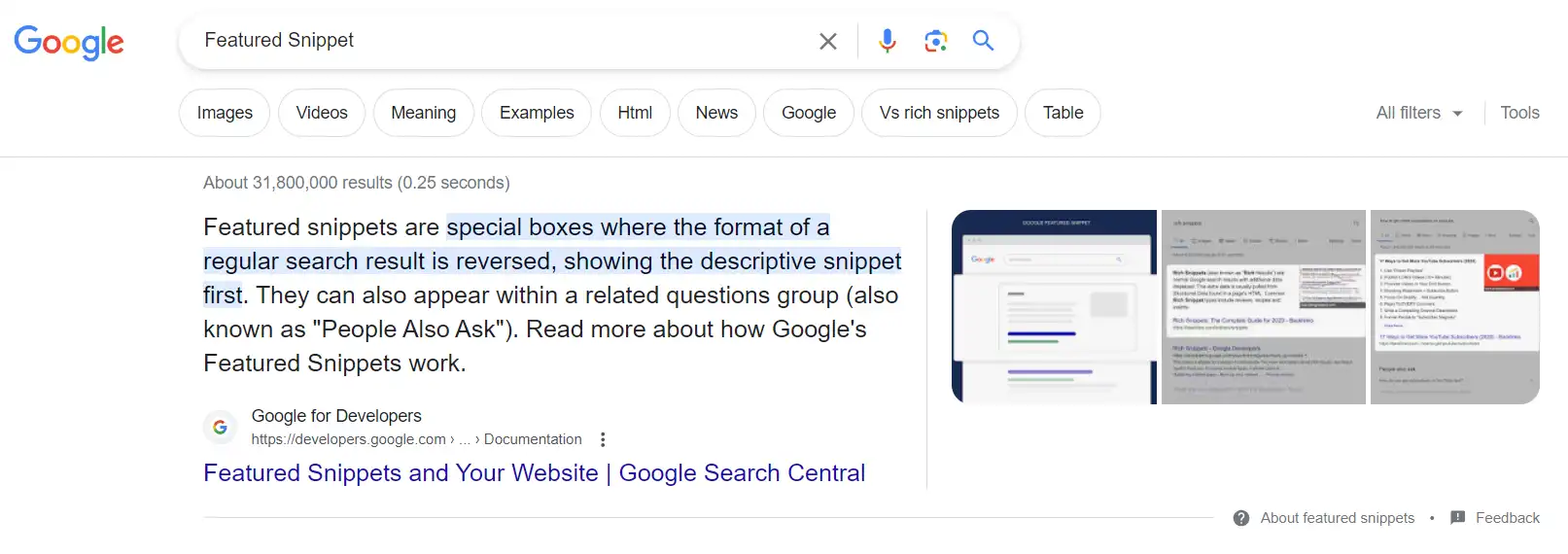
Knowledge Panel
Knowledge panels provide information on the main topic of a search query, which occurs often if the query is related to a person or a company. On mobile, they generally appear near the top of SERPs, while on desktop, they appear on the right-hand side. Most of the information in knowledge panels comes from trusted sources such as Wikidata, Wikipedia, Google’s Knowledge Graph, and verified social media profiles.
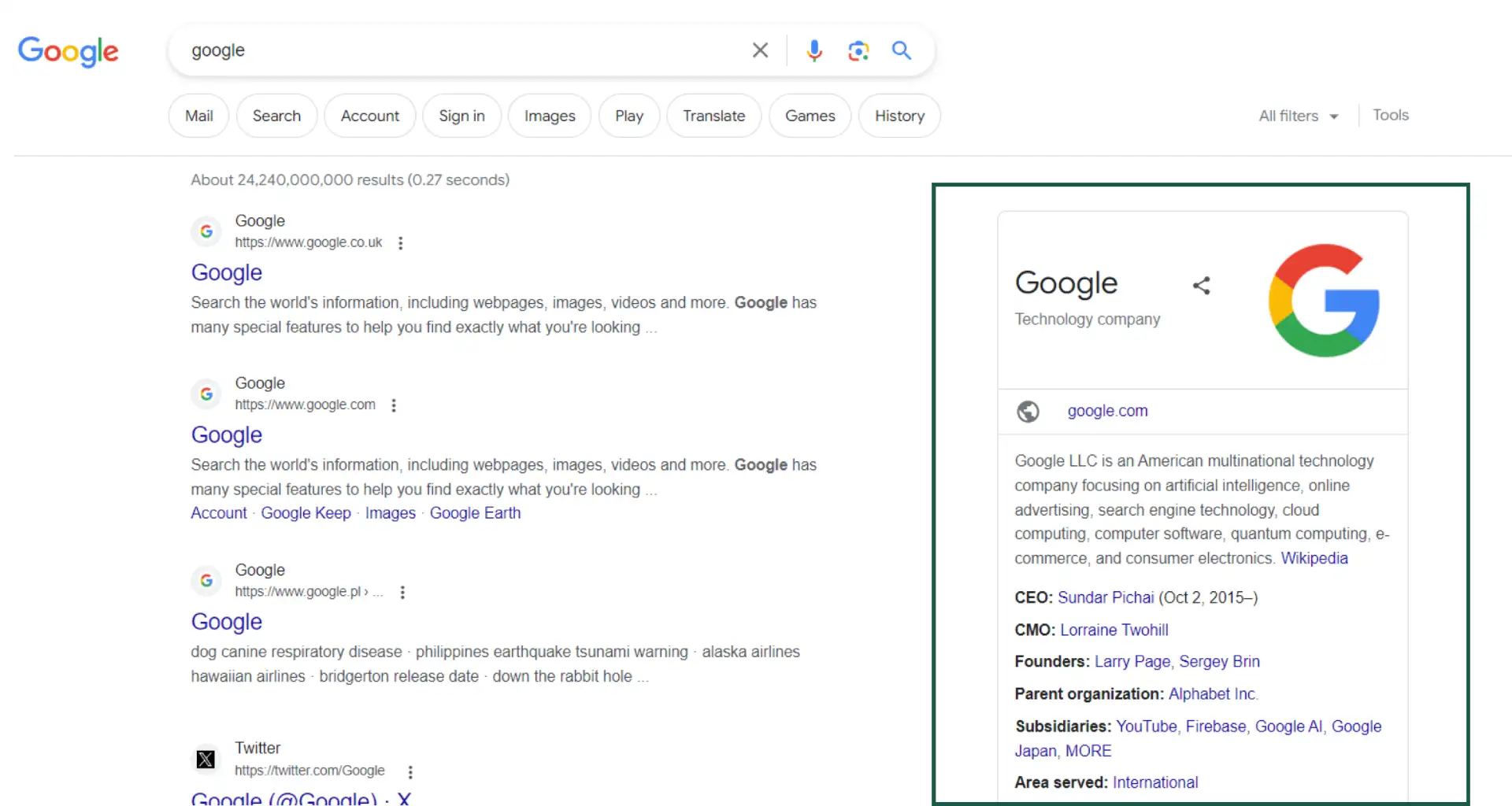
Knowledge Card
Knowledge cards sit at the top of SERPs and offer a short, concise answer to the search query. They come in different formats depending on the query and the answer provided. The main sources of information for Knowledge cards come from Google’s Knowledge Graph, data partners, and other trusted sources such as official government bodies and Wikipedia.
Image Pack
An image pack shows a group of thumbnails. When a user clicks on them, they are immediately directed to Google Images. They typically appear at the top of SERPs but can also appear further down the page. Sometimes Image packs are also displayed as scrollable carousels.

People Also Ask (PAA)
People Also Ask (PAA) boxes show any related questions that searchers typically ask the search engine. Each question will roll down and reveal an answer. This answer is pulled from a webpage, and it is displayed in a similar manner to Featured snippets. Google also loads more related questions every time an answer is clicked and revealed.
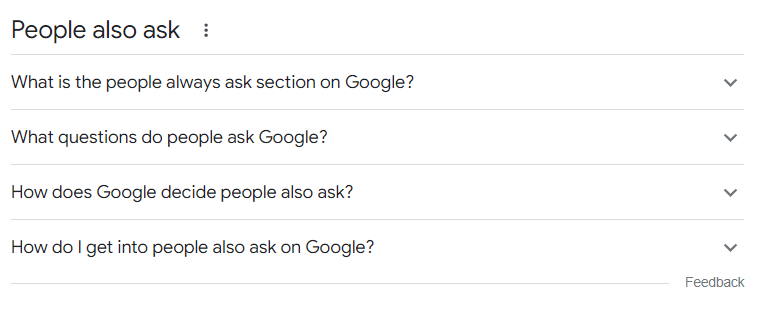
Top Stories
Top stories show carousels of recently published live blogs, articles, news, and videos. Google will display a title, thumbnail, the publisher’s name, and timestamp for each result. Top stories generally appear at the top of SERPs, especially if they are about news and current events. For other queries, it may appear lower down instead.
Tweet Boxes
2015 saw Google partnering with Twitter (now known as X) to start indexing tweets in real time. Tweet boxes often display recent popular tweets in a carousel. They are usually from an official Twitter account that is relevant to the particular search query. That said, tweet boxes will sometimes show tweets from several accounts.

Shopping Results
Otherwise known as Product Listing Ads (PLAs), shopping results showcase relevant products coming from paid advertisers. Every result lists a product name, a price, and the retailer. Some results will even list reviews and certain special offers as well. Most Shopping results come up for queries that have a commercial or transactional search intent, such as ‘buy cat food’ or ‘best desk lamp’.
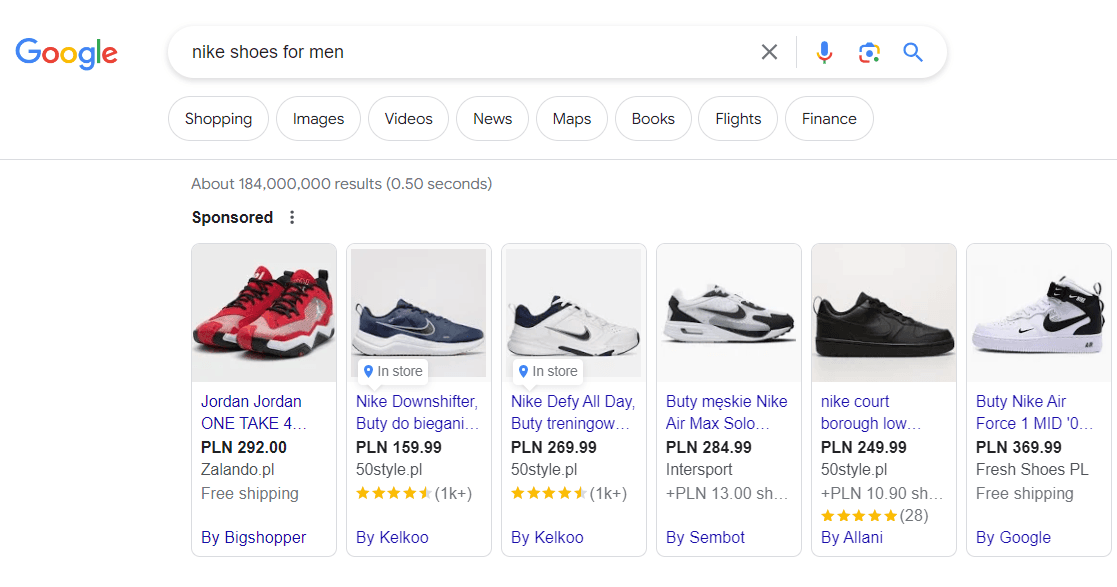
Sitelinks
Sitelinks are links to other pages or sections of a page that appear under some Google search results. They usually appear under a main domain link result. This means users can find what they are searching for faster, and they are also more likely to click on a website in the SERP, leading to more organic traffic.
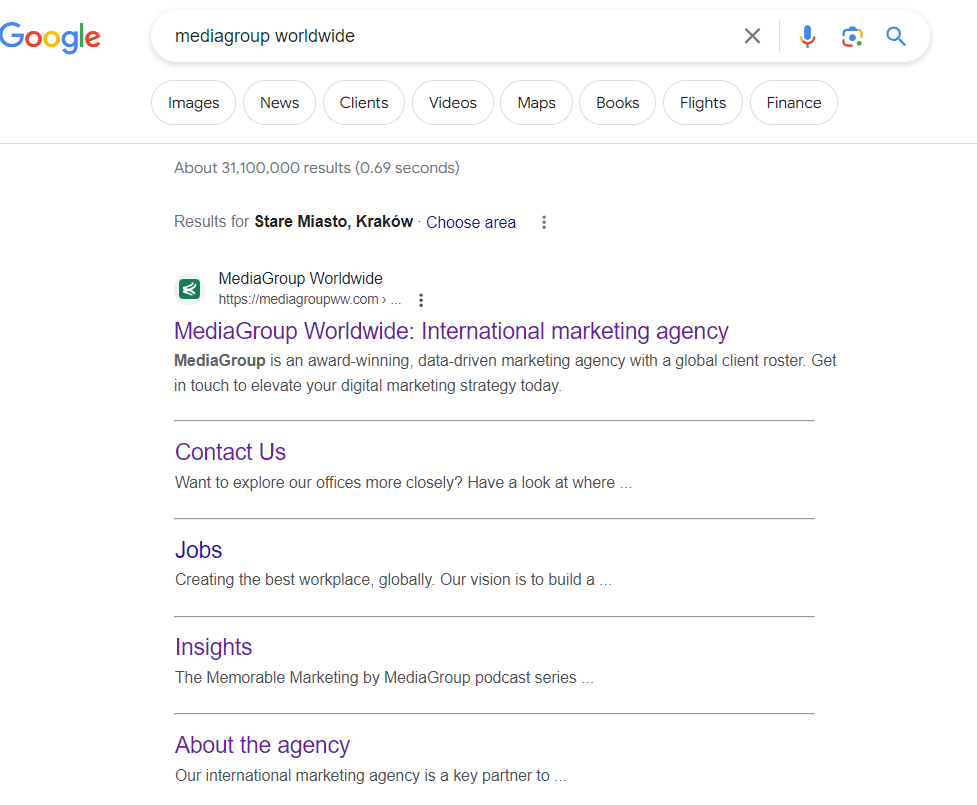
Videos
Video results are organic results that are complemented with a video thumbnail. Only pages that have embedded videos are eligible for this feature. Google will also show the upload duration, date, and name of who uploaded the video in the SERP. While most videos do come from YouTube, they can also come from other websites too.

SEO best practices for winning SERP features
Depending on the query that you are optimizing for, it is possible to increase your chances of appearing as a SERP feature, which could boost your organic traffic. Here are a few best practices to keep in mind below:
Getting Sitelinks
Sitelinks demonstrate other important links that make up a website. They appear when Google finds them strongly relevant to a particular search query. The main goal of showing sitelinks is to help users go to relevant web pages directly from the search result.
As sitelinks are automated, they cannot be removed from one’s website. To feature sitelinks on SERPs, a website should have:
- Descriptive and relevant anchor texts of internal links
- Relevant, informative and compact page headings and titles
- Enough relevant internal links between pages
Optimizing for an Image Pack
As mentioned, the image pack appears when Google believes visual content would be helpful to the searcher. As such, businesses and websites can optimize for this Google SERP feature by providing context around the images that appear. This means:
- Using descriptive file names.
- Providing a caption for the image.
- Providing alt text.
- Including images where they fit contextually in the content.
- Having a good URL structure and an image sitemap.
Gaining a Featured Snippet
A featured snippet sits at the top of Google’s search results. They extract content from the webpage that provides the best and most relevant answer for the search query. There are a few best practices to make sure to gain a Featured snippet, including:
- Make sure content is succinct and avoids wordy sentences.
- Use phrases and words that audiences are likely to use.
- Provide the answer as soon as possible.
- Pat attention to how a Featured snippet is formatted.
Optimizing for a Local Pack
Also known as a Map pack, a Local pack showcases the top three local results that show up when Google believes a viewer wants to see a local result. The Local pack will also display a map with pins and locations, as well as a rating scale for each location.
To optimize for a Local pack, a website needs to follow local SEO best practices. This includes things like:
- Getting accurate NAP citations.
- Increasing the number of online reviews.
- Optimizing one’s Google Business Profile.
- Creating location-specific landing pages for locations that a business serves.
Bottom line
Overall, achieving success in the SERPs is a great way for businesses to gain more traffic to their site, which can lead to more engagement and conversions in the long run. As search engines continue to refine their algorithms and user preferences evolve, staying attuned to these changes is key to maintaining a prominent position in the SERPs. Businesses that operate online should aim to produce content that is relevant and authoritative and aim to cultivate user satisfaction. When pages are aligned with what search engines are looking for, businesses are well-positioned to achieve enduring organic visibility for their brand.
Contact us for an SEO consultation
If you are looking to optimize your website’s SEO, then MediaGroup can assist you. We have a team of SEO specialists across Asia and Europe who can help you build a suitable SEO strategy for your needs to increase digital visibility on SERPs and beyond. Contact us today for a consultation.
SEO Content Manager
Clarissa is an SEO Content Manager at MediaGroup Worldwide. She has 1.5 years of experience working with clients in the financial and tech sectors, creating strategies and producing copy across a wide range of content types, including landing pages, educational articles, and white papers.
Popular categories:
The Memorable Marketing by MediaGroup podcast series interviews leading senior marketers worldwide on all things marketing, campaigns, strategy, building awareness and everything that makes a brand successful.
Join the conversation by leaving your thoughts and questions, and we will be happy to chat with you. If you want to discuss your business marketing strategies in more detail or join our podcast as a guest, please reach out to us at: [email protected]
Latest Insights
Article
How to conduct keyword and content research for your SEO content strategy
By finding the right keywords that suit your target audience, your website has the potential to rank higher in search engine rankings and potentially generate more organic traffic, which can lead to more conversions. In this article, we take a deep dive into what keyword and content research are, why they are important, and how to conduct them as a part of your SEO content strategy.
Written by Clarissa Siu
Quarterly marketing insights in our newsletter
We are committed to helping you get the best results in your digital marketing game. Our experts will give you actionable insights and knowledge, based on our experience, to tackle the biggest marketing challenges. Unsubscribe at any time.
Mediagroup Worldwide processes the above information in order to subscribe you to the newsletter. Privacy Policy
